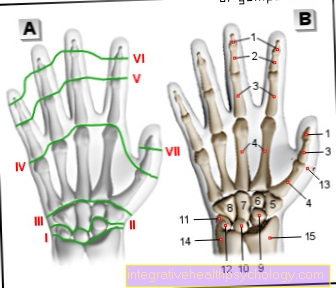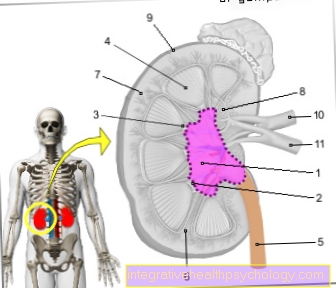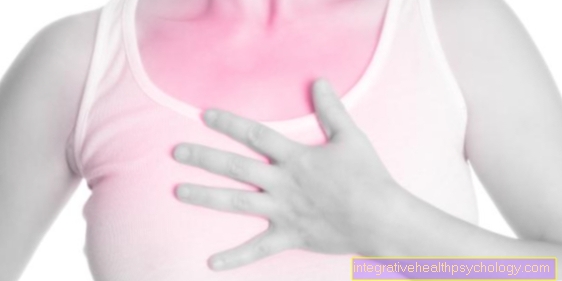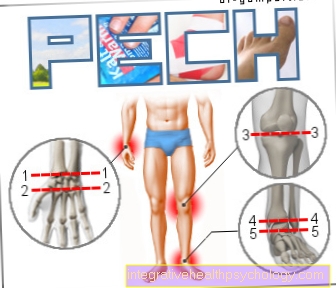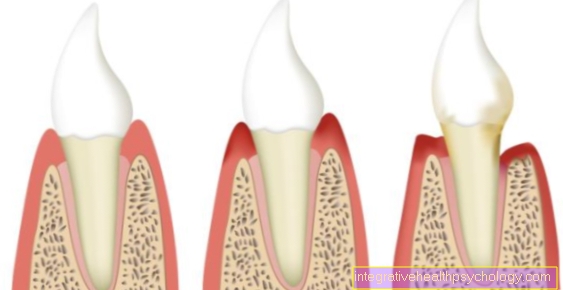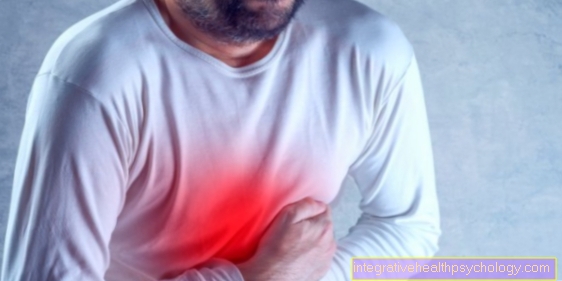Peripheral arterial disease causes
What are the causes of PAD?
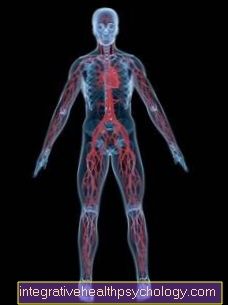
The following are considered risk factors:
- Smoke (Main risk factor)
- Diabetes (Diabetes mellitus) (Main risk factor)
- high blood pressure (Hypertension)
- Lipid metabolism disorders
- Obesity
- genetic causes
The main cause of a peripheral arterial disease (PAD) is the calcification of the arteries (arteriosclerosis). This leads to a Narrowing (Stenosis) or a blockage (occlusion) of an artery, which can now only insufficiently supply its supply area with blood. Since the blood transports oxygen in the body and the tissue is dependent on a constant supply of oxygen, pain and even tissue breakdown (necrosis) can arise.
Hence the body tries at that peripheral arterial diseaseto compensate for the inadequate oxygen supply. Already existing small Arteries are now supplied with more blood and begin to grow. They can then carry a larger volume of blood and thus bypass the affected, narrowed artery. This is called Bypass circuits (Collaterals).
The "remaining supply" depends on the length and degree of the constriction, as well as the oxygen consumption of the tissue. In addition, Bypass circuits form to ensure a blood supply.
This explains why peripheral arterial occlusive disease often does not cause any symptoms at first.
In addition, a deterioration in physical performance caused by other factors can mask peripheral arterial occlusive disease. In patients with Heart failure (Heart failure), COPD (Chronic constricting lung disease) or severe bronchial asthma can e.g. The shortness of breath means that they have to stop before the pain from exhaustion occurs.
Pain only occurs when the oxygen supply to the tissue is no longer sufficient (Ischemia). They then make themselves felt in the area behind the constriction. Since our tissue relies on a permanent supply of oxygen, severe constrictions or total occlusions can even lead to tissue destruction (necrosis) (see complaints / symptoms).
In rare cases, symptoms may suddenly appear (pain, paleness, feeling cold, numbness of the legs / arms). Then there may be an acute vascular occlusion that is caused by Blood clots (Embolism or thrombus). This cause is usually found in the area of the vascular bifurcations, as there is a natural vascular constriction here. This creates a sudden lack of oxygen (Ischemia). The discomfort, such as sudden leg or stomach pain, are more noticeable here, since the bypass cycles (Collaterals) not like in arteriosclerosis (Vascular calcification) were able to train and strengthen slowly.
A further subdivision of peripheral arterial occlusive disease (PAD) can be made according to the vessel size: The disease of the large arteries (e.g. femoral artery = arteria femoralis) is called Macroangiopathy, on the other hand, the disease of the small and smallest arteries as microangiopathy. The Microangiopathy occurs especially in diabetics (Diabetes mellitus) in front.
The subdivision is important for the choice of Therapy of peripheral arterial disease.
In the special case of Lériche syndrome there is a closure of the main artery bifurcation (Aortic bifurcation). Here, too, arteriosclerosis or a clot (thrombosis, Embolism) and the resulting narrowing to an insufficient supply of oxygen.
Due to the special location, there are additional complaints. So in addition to leg pain, paleness and feeling cold too sciatica-like pain (from the sacrum on the back of the thigh to the hollow of the knee), Impotence / erectile dysfunction and Bladder and rectal disorders occur.
The causes at M. Winiwarter-Buerger is not exactly clarified.
This disease is very similar to peripheral arterial disease, even becoming one of the rare causes of peripheral arterial disease counted. The symptoms are almost the same, but the classic causes of PAD are not found. However, play mostly Smoke, as well as genetic predisposition and circulating immune complexes play a role.
Even with that Takayasu syndrome the mechanism of formation is unknown. The Takayasu syndrome is one of the inflammation of blood vessels (vasculitides) and is an inflammation of the main artery (aorta). It is also counted among the rare causes of peripheral arterial disease.
The symptoms are that peripheral arterial disease similar, but often affect the arms and can also cause blurred vision, chewing problems, or strokes Fainting spells include. Here, too, there is no arteriosclerosis.
Therapy consists of suppressing the Immune system (Immunosuppression) and is otherwise the same as the peripheral arterial disease.


